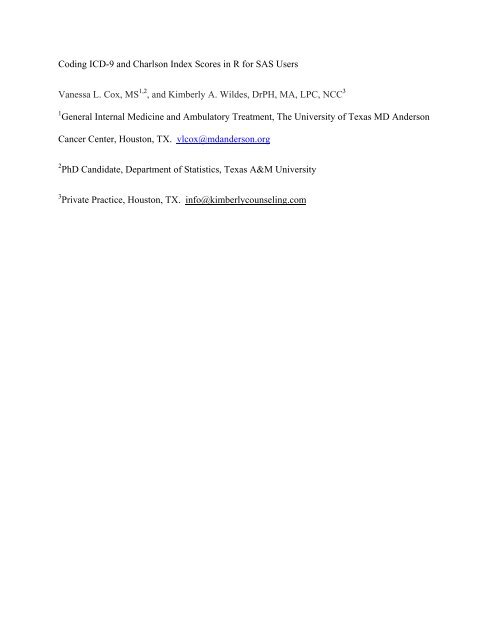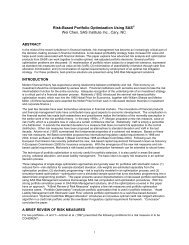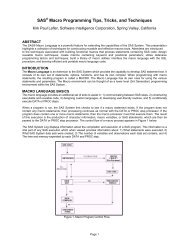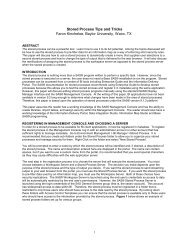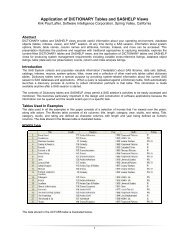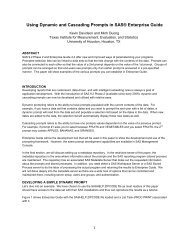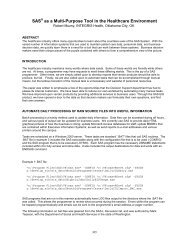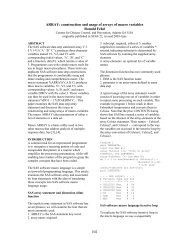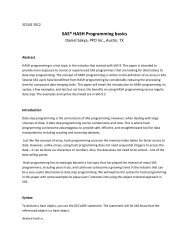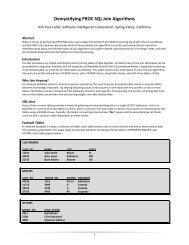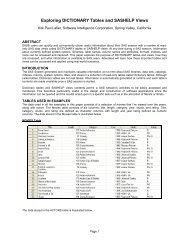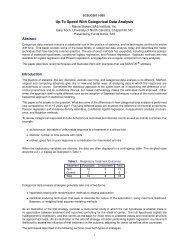Coding ICD-9 and Charlson Index Scores in R for SAS Users ...
Coding ICD-9 and Charlson Index Scores in R for SAS Users ...
Coding ICD-9 and Charlson Index Scores in R for SAS Users ...
Create successful ePaper yourself
Turn your PDF publications into a flip-book with our unique Google optimized e-Paper software.
<strong>Cod<strong>in</strong>g</strong> <strong>ICD</strong>-9 <strong>and</strong> <strong>Charlson</strong> <strong>Index</strong> <strong>Scores</strong> <strong>in</strong> R <strong>for</strong> <strong>SAS</strong> <strong>Users</strong><br />
Vanessa L. Cox, MS 1,2 , <strong>and</strong> Kimberly A. Wildes, DrPH, MA, LPC, NCC 3<br />
1 General Internal Medic<strong>in</strong>e <strong>and</strong> Ambulatory Treatment, The University of Texas MD Anderson<br />
Cancer Center, Houston, TX. vlcox@md<strong>and</strong>erson.org<br />
2 PhD C<strong>and</strong>idate, Department of Statistics, Texas A&M University<br />
3 Private Practice, Houston, TX. <strong>in</strong>fo@kimberlycounsel<strong>in</strong>g.com
Introduction:<br />
<strong>ICD</strong>-9 codes are used <strong>in</strong> large hospital <strong>and</strong> medical record databases to capture patient<br />
comorbidity <strong>in</strong><strong>for</strong>mation <strong>and</strong> cause of death. By weight<strong>in</strong>g certa<strong>in</strong> comorbidities, the <strong>Charlson</strong><br />
<strong>Index</strong> calculates a comorbidity score that assigns a level of health to an <strong>in</strong>dividual. Account<strong>in</strong>g<br />
<strong>for</strong> or controll<strong>in</strong>g <strong>for</strong> patient comorbidity <strong>in</strong> statistical analyses, <strong>for</strong> example <strong>in</strong> survival analysis,<br />
is crucial <strong>and</strong>, <strong>in</strong> fact, generally expected, as demonstrated by the widely reported use of<br />
comorbidity scores <strong>in</strong> the scientific literature,. <strong>Cod<strong>in</strong>g</strong> algorithms <strong>for</strong> the <strong>Charlson</strong> <strong>Index</strong> exist<br />
<strong>for</strong> <strong>SAS</strong> <strong>and</strong> SPSS; however, such algorithms do not exist <strong>for</strong> analyses with R.<br />
The most difficult part of develop<strong>in</strong>g a cod<strong>in</strong>g algorithm function <strong>in</strong> R <strong>for</strong> the <strong>Charlson</strong> <strong>Index</strong> is<br />
data manipulation. It is common to use script<strong>in</strong>g languages to prepare datasets <strong>for</strong> analysis with<br />
R. The goal of this project was to develop an R scor<strong>in</strong>g package that was “all <strong>in</strong>clusive” <strong>and</strong><br />
could be run with m<strong>in</strong>imal data preparation <strong>in</strong> order to compute the <strong>Charlson</strong> <strong>Index</strong>.<br />
<strong>ICD</strong>-9<br />
Wikipedia def<strong>in</strong>es International Statistical Classification of Diseases <strong>and</strong> Related Health<br />
Problems (<strong>ICD</strong>) as “codes to classify diseases <strong>and</strong> a wide variety of signs, symptoms, abnormal<br />
f<strong>in</strong>d<strong>in</strong>gs, compla<strong>in</strong>ts, social circumstances, <strong>and</strong> external causes of <strong>in</strong>jury or disease. Under this<br />
system, every health condition can be assigned to a unique category <strong>and</strong> given a code, up to six<br />
characters long. Such categories can <strong>in</strong>clude a set of similar diseases.” The <strong>ICD</strong> cod<strong>in</strong>g is<br />
currently <strong>in</strong> version 10, with version 11 expected to be released <strong>in</strong> 2015. However, version 9 is<br />
commonly used <strong>in</strong> data sets that are be<strong>in</strong>g analyzed currently. Version 10 is be<strong>in</strong>g used to code
new <strong>in</strong><strong>for</strong>mation. The <strong>ICD</strong> codes are published by the World Health Organization <strong>and</strong> are nearly<br />
ubiquitously used <strong>in</strong> hospital bill<strong>in</strong>g <strong>and</strong> patient records.<br />
For example, consider the follow<strong>in</strong>g classifications <strong>for</strong> elbow <strong>and</strong> hypertension. Each<br />
classification level branches off <strong>in</strong>to more specific categories:<br />
Example 1: Dislocated elbow - coded as 832 based on the follow<strong>in</strong>g classification:<br />
Injury <strong>and</strong> Poison<strong>in</strong>g->Dislocation->elbow<br />
Example 2: Hypertension – coded as 401.x as follows:<br />
Diseases of circulatory system->hypertensive diseases->essential hypertension->Hypertension<br />
Hypertension cod<strong>in</strong>g would cont<strong>in</strong>ue <strong>in</strong>to Hypertension (benign), Hypertension (malignant), or<br />
Hypertension (unspecified) with codes 401.0, 401.1, or 401.9, respectively.<br />
<strong>Charlson</strong><br />
The <strong>Charlson</strong> <strong>Index</strong> was designed to predict one-year mortality <strong>for</strong> a patient by exam<strong>in</strong><strong>in</strong>g 22<br />
medical conditions. Each condition is assigned a weight of 1, 2, 3, or 6 depend<strong>in</strong>g on the level of<br />
its impact on mortality. The weighted conditions are then summed, with a higher score<br />
correspond<strong>in</strong>g to a higher risk of mortality.<br />
It is possible to have multiple comorbidities per patient because comorbidity data are often<br />
collected across time <strong>and</strong> across multiple visits. It is usually expected that none of these<br />
comorbidities medically resolve. There<strong>for</strong>e, we would like to capture all of the comorbidities<br />
that each patient has reported at least once. The <strong>Charlson</strong> <strong>Index</strong> assigns a value to a patient’s
health by assess<strong>in</strong>g a set of comorbidities, some with higher ranks than others. This <strong>in</strong>dex has<br />
been validated <strong>in</strong> numerous studies as to the accuracy of patient health denoted by the <strong>Charlson</strong><br />
<strong>Index</strong> rat<strong>in</strong>g. The <strong>ICD</strong>-9 code is a way to st<strong>and</strong>ardize how comorbidities are recorded. With so<br />
much electronic <strong>in</strong><strong>for</strong>mation available, a st<strong>and</strong>ardized system <strong>for</strong> collect<strong>in</strong>g disease <strong>in</strong><strong>for</strong>mation<br />
becomes extremely helpful when analyz<strong>in</strong>g data.<br />
The <strong>Charlson</strong> R package created <strong>in</strong> this project accomplishes two th<strong>in</strong>gs. First, it recodes<br />
Statistical Classification of Diseases <strong>and</strong> Related Health Problems version 9 (<strong>ICD</strong>-9) entries <strong>in</strong>to<br />
categories useful <strong>for</strong> comput<strong>in</strong>g the <strong>Charlson</strong> <strong>Index</strong>. Second, it computes the <strong>Charlson</strong> <strong>Index</strong> <strong>for</strong><br />
entries <strong>in</strong> a dataset. It conta<strong>in</strong>s one function named <strong>Charlson</strong>, which takes two vector arguments.<br />
Methods<br />
A function named <strong>Charlson</strong> was developed <strong>in</strong> R (Complete code is <strong>in</strong> Appendix 1). After<br />
writ<strong>in</strong>g the function, an R package was built. The package <strong>in</strong>cludes the code, a description of the<br />
code, <strong>in</strong>put variables, output from the function, sample data set, <strong>and</strong> examples. This package<br />
requires the Reshape <strong>and</strong> Plyr packages to run properly. The melt <strong>and</strong> cast functions from<br />
Reshape are used <strong>in</strong> <strong>Charlson</strong>, while the Reshape package itself requires Plyr. To create an R<br />
package, the basic steps per<strong>for</strong>med were:<br />
1. Open a clean R session.<br />
2. Load the data sets.<br />
3. Run the functions.<br />
4. Run the function package.skeleton. This created the basic structure of the files <strong>and</strong><br />
directories needed <strong>for</strong> a package.
5. Update <strong>and</strong> modify all of the files created.<br />
6. From the batch prompt, type “R CMD check package-name”. Correct any errors or<br />
warn<strong>in</strong>gs.<br />
7. If there were not any errors or warn<strong>in</strong>gs, from the batch prompt, type “R CMD build<br />
package-name”.<br />
A summary of the code <strong>for</strong> the <strong>Charlson</strong> function is listed below.<br />
• Input the data (column 1 = Patient ID, column 2 = <strong>ICD</strong>-9 codes).<br />
• Initialize a vector <strong>for</strong> the disease codes.<br />
• Create vectors of disease codes (based on <strong>ICD</strong>-9 codes) <strong>for</strong> each of the 23 disease<br />
categories: Acute Myocardial Infarction, Congestive Heart Failure, Peripheral Vascular<br />
Disease, Cerebrovascular Disease, Dementia, Chronic Pulmonary Disease,<br />
Rheumatologic Disease, Peptic Ulcer Disease, Mild Liver Disease, Diabetes without<br />
complications, Diabetes with chronic complications, Hemiplegia or Paraplegia, Renal<br />
Disease, Cancer, Moderate or Severe Liver Disease, Metastatic Carc<strong>in</strong>oma, <strong>and</strong><br />
AIDS/HIV. Each of these vectors could conta<strong>in</strong> one or more disease codes, depend<strong>in</strong>g on<br />
the number of <strong>ICD</strong>-9 codes that correspond to that illness/condition.<br />
• Check row by row <strong>for</strong> each disease category, assign correspond<strong>in</strong>g disease classification<br />
to <strong>ICD</strong>-9 code, denoted “ch1” to “ch17”.<br />
• Add rows to the end with one of each of the comorbidities to ensure even categories that<br />
no patients have a variable created when transposed. The ID <strong>for</strong> this row is marked<br />
“xxxREMOVExxx” to ensure it is not accidentally <strong>in</strong>cluded <strong>in</strong> the f<strong>in</strong>al data set.<br />
• Use the melt function <strong>in</strong> the Reshape package to summarize the data by patients.
• Use the cast function <strong>in</strong> the Reshape package to transpose the data by Patient ID.<br />
• Replace any disease category count over 1 with a 1 to <strong>in</strong>dicate presence. Note, the<br />
number of times a disease is recorded is not important <strong>in</strong> scor<strong>in</strong>g the <strong>Charlson</strong> <strong>Index</strong>.<br />
• Assign appropriate weights per disease category.<br />
• Compute a comorbidity count <strong>for</strong> each patient.<br />
• Compute the <strong>Charlson</strong> <strong>Index</strong> <strong>for</strong> each patient.<br />
• Return the f<strong>in</strong>al dataset.<br />
The beg<strong>in</strong>n<strong>in</strong>g of the program classifies each <strong>ICD</strong>-9 code to the correspond<strong>in</strong>g disease category<br />
<strong>for</strong> the <strong>Charlson</strong>. The data are then transposed by patient so that across each patient row we can<br />
see which of the disease categories are present. Then a count of comorbidities <strong>and</strong> the <strong>Charlson</strong><br />
<strong>Index</strong> is calculated.<br />
Portion of sample <strong>in</strong>put data:
Correspond<strong>in</strong>g Sample Output Data:<br />
Results<br />
Creation of a program to code the <strong>Charlson</strong> <strong>Index</strong> resulted <strong>in</strong> the follow<strong>in</strong>g R code. The code ran<br />
without any errors or warn<strong>in</strong>gs. The dataset used to validate the function was the National<br />
Health <strong>and</strong> Nutrition Exam<strong>in</strong>ation Survey (NHANES) mortality file from 1992. Accord<strong>in</strong>g to<br />
their website, “The updated NHANES II L<strong>in</strong>ked Mortality File provides mortality follow-up data<br />
through December 31, 2006 <strong>for</strong> the 9,252 NHANES II participants who were 30-75 years of age<br />
<strong>and</strong> completed a medical exam<strong>in</strong>ation dur<strong>in</strong>g the survey period (1976-1980).” These data are not<br />
<strong>for</strong> public use, there<strong>for</strong>e, a sample data file that had a similar layout to the mortality file was<br />
created.<br />
R code:<br />
# Function <strong>in</strong>put is a vector of patient ID <strong>and</strong> a vector of correspond<strong>in</strong>g <strong>ICD</strong>-9 codes<br />
charlson
# <strong>in</strong>itialize code variable<br />
d$code
can
}<br />
# Select case number <strong>and</strong> disease class<br />
#Need to add this to the end of dvars so all codes will be there<br />
ch
mydata2$ch8 0, 1,0)<br />
mydata2$ch9 0, 1,0)<br />
mydata2$ch10 0, 1,0)<br />
mydata2$ch11 0, 1,0)<br />
mydata2$ch12 0, 1,0)<br />
mydata2$ch13 0, 1,0)<br />
mydata2$ch14 0, 1,0)<br />
mydata2$ch15 0, 1,0)<br />
mydata2$ch16 0, 1,0)<br />
mydata2$ch17 0, 1,0)<br />
#get weights - the last 6 comorbidities have <strong>in</strong>creased weights assigned to them<br />
# get a count of comorbidities <strong>and</strong> the <strong>Charlson</strong> <strong>Index</strong> score<br />
<strong>for</strong> (i <strong>in</strong> 1:nrow(mydata2)) {<br />
mydata2$comorbidity.n[i]
mydata2$ch6[i], mydata2$ch7[i], mydata2$ch8[i],<br />
mydata2$ch9[i], mydata2$ch10[i],<br />
mydata2$ch11[i], 2*mydata2$ch12[i], 2*mydata2$ch13[i],<br />
2*mydata2$ch14[i], 3*mydata2$ch15[i], 6*mydata2$ch16[i],<br />
6*mydata2$ch17[i])<br />
}<br />
# dropp<strong>in</strong>g the extra row, the last row with a 1 <strong>for</strong> each category so<br />
all would be counted<br />
mydata3
This R package will be useful to any programmer with data conta<strong>in</strong><strong>in</strong>g <strong>ICD</strong>-9 disease codes. In<br />
addition, it would be easy to <strong>in</strong>corporate more <strong>ICD</strong>-9 codes <strong>in</strong>to the package to develop other<br />
cod<strong>in</strong>g algorithms based on these codes <strong>for</strong> other disease <strong>in</strong>dices. <strong>Cod<strong>in</strong>g</strong> algorithms based on<br />
<strong>ICD</strong>-9 currently exist to stratify severity of Crohn’s Disease, hospital mortality <strong>in</strong> pediatric<br />
patients, <strong>and</strong> many other diseases. Future applications would <strong>in</strong>clude add<strong>in</strong>g the classifications<br />
<strong>for</strong> <strong>ICD</strong>-10 codes to give the user the choice of choos<strong>in</strong>g <strong>ICD</strong>-9 or <strong>ICD</strong>-10 codes.
References:<br />
<strong>Charlson</strong> ME, Pompei P, Ales KL, MacKenzie CR (1987). A new method of classify<strong>in</strong>g<br />
prognostic comorbidity <strong>in</strong> longitud<strong>in</strong>al studies: development <strong>and</strong> validation. J Chron Dis, 40(5):<br />
373-383.<br />
Comorbidity [Internet]. Los Angeles (CA): Wikipedia, The Free Encyclopedia; [updated 2010<br />
Mar 27; cited 2010 May 5]. Available from: http://en.wikipedia.org/wiki/Comorbidity<br />
Greenfield S, Apolone G, McNeil BJ, Cleary PD: The importance of co-existent disease <strong>in</strong> the<br />
occurrence of postoperative complications <strong>and</strong> one-year recovery <strong>in</strong> patients undergo<strong>in</strong>g total hip<br />
replacement. Comorbidity <strong>and</strong> outcomes after hip replacement. Med Care 1993, 31:141-154.<br />
de Groot V, Beckerman H, Lankhorst GJ, Bouter LM: How to measure comorbidity. a critical<br />
review of available methods. J Cl<strong>in</strong> Epidemiol 2003, 56:221-229.<br />
<strong>ICD</strong>-9 [Internet]. Los Angeles (CA): Wikipedia, The Free Encyclopedia; [updated 2010 Mar 27;<br />
cited 2010 May 5]. Available from: http://en.wikipedia.org/wiki/<strong>ICD</strong>9<br />
Kaplan MH, Fe<strong>in</strong>ste<strong>in</strong> AR: The importance of classify<strong>in</strong>g <strong>in</strong>itial co-morbidity <strong>in</strong> evaluation the<br />
outcome of diabetes mellitus. J Chronic Dis 1974, 27:387-404.<br />
Miller MD, Paradis CF, Houck PR, Mazumdar S, Stack JA, Rifai AH, Mulsant B, Reynolds CF<br />
III: Rat<strong>in</strong>g chronic medical illness burden <strong>in</strong> geropsychiatric practice <strong>and</strong> research: application of<br />
the Cumulative Illness Rat<strong>in</strong>g Scale. Psychiatry Res 1992, 41:237-248.
Murray SB, Bates DW, Ngo L, Ufberg JW, Shapiro NI. <strong>Charlson</strong> <strong>Index</strong> is associated with oneyear<br />
mortality <strong>in</strong> emergency department patients with suspected <strong>in</strong>fection. Acad Emerg Med.<br />
2006 May;13(5):530-6. Epub 2006 Mar 21.<br />
Quan H, Sundararajan V, Halfon P, et al. <strong>Cod<strong>in</strong>g</strong> algorithms <strong>for</strong> def<strong>in</strong><strong>in</strong>g Comorbidities <strong>in</strong> <strong>ICD</strong>-<br />
9-CM <strong>and</strong> <strong>ICD</strong>-10 adm<strong>in</strong>istrative data. Med Care. 2005 Nov; 43(11): 1130-9.<br />
Von KM, Wagner EH, Saunders K: A chronic disease score from automated pharmacy data.<br />
J Cl<strong>in</strong> Epidemiol 1992, 45:197-203.
Appendix 1 – Example <strong>in</strong>put data


